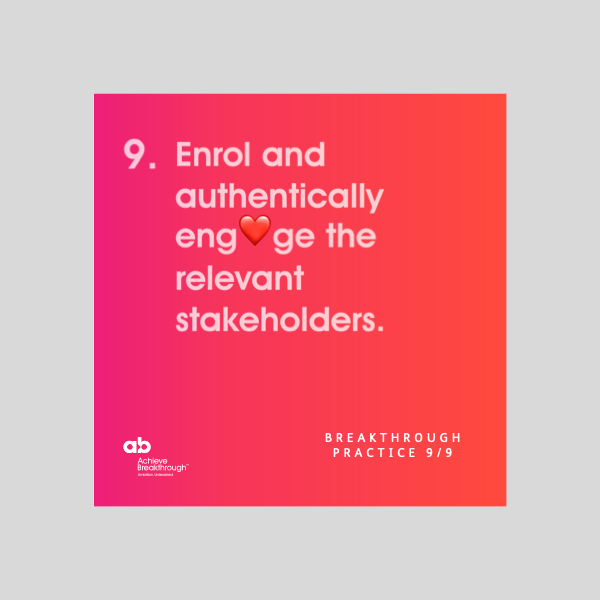Breakthrough Thinking Practice 9: Enrol and authentically engage the relevant stakeholders
Leadership Blog | 4 minute read

Written by Achieve Breakthrough

In this blog we conclude our Breakthrough Practices journey together. Hopefully, over these nine blogs I've given you a good feel for the sort of behavioural and mindset practices you can adopt to become more transformational in your leadership style.
Before we get into enrolling stakeholders - the theme of this final practice 9 - why don't you catch up on the previous eight if you haven't already? Thanks for reading.
---------------------------------------
You can’t hack enrolment: Why inspiring your teams is not enough
In leadership circles, a great deal is made about the importance of storytelling. And it’s fair to say, inspiring your organisation to achieve a goal is a giant leap forward from the control paradigm of leadership – in which mandates are given and expected to be followed without reason – but as we’re going to explore, it’s not quite enough
If you want to achieve the impossible, you’ll need to do more than paint an enticing vision of the future. You’re going to have to let your people see your half-finished sketches and take up the brushes themselves.
Storytelling isn’t about selling the dream
It was Eisenhower who said, “Leadership is the art of getting someone else to do something you want done because he wants to do it.” And he had quite a gift for instilling optimism and vision in the people around him. When you listen to his old speeches, you can almost hear the American flag rippling in the wind.
Of course, after his stirring speech, troops wanted to step up and serve. But that was also a different era, with different expectations. When was the last time a politician gave a speech that brought the whole country together? People are more sceptical now, and they’re highly attuned to any kind of speech that sounds like veiled coercion.
As we've pointed out before in our article on transformation, your employees are not customers. Storytelling is less about selling them a dream, and more about helping people understand what you mean. Once they understand what’s at stake, they will make their own choices, even if, in a hierarchical organisation, those choices might have consequences,
So maybe Eisenhower had it slightly wrong. Of course, as a leader, you want to instil the need in people’s minds to achieve the impossible. But it might not be about making people do something you want done, at all.
Making people part of the idea
For people to deliver their life’s best work, mandates and control are detrimental. Mandates make things happen, but rarely improbable, impossible things. Ultimately this paradigm leaves you surrounded by ‘yes’ people who can’t push the envelope because they can’t challenge.
Inspiring your people to achieve a goal might take you a step closer to a breakthrough, but storytelling can’t hack enrolment. Unless people feel part of the idea and empowered by it, unless they feel ownership and a sense of urgency, they’re not going to collaborate and act beyond their accepted limits.
The power of true enrolment
If a party is not willing to feel 100% responsible for the outcome, collective breakthrough won’t happen.
When people are properly enrolled, they will take on a sense of leadership, ownership and accountability for things that go beyond their remit. Essentially, it’s the opposite of blame mentality.
This doesn’t mean that you need to replicate a start-up, in which every team member wears five hats, everyone’s toes are stepped on and no one knows who the buck stops with. It’s possible to have high levels of organisation and process while still going beyond your bullet point list of duties and KPIs in who you’re being.
Likewise, people may delegate, but they stay connected to the outcome. They don’t simply pass on responsibility - because the collective breakthrough matters to them.
This sense of ownership also enables them to spot opportunities and declare breakdowns beyond their usual remit, and as a result everyone can achieve beyond the usual outcomes too.
So how do you achieve it?
First, you need to ask whether your organisation or team is aligned to the need you are looking to create – to go global, to double turnover, to achieve net-zero in two years, to become the most sought-after team in the region, etc.
Here transparency is a lifesaver. If your teams aren’t aligned, you might as well fail fast. Of course, you can work to align people, but there might be a simpler avenue. You could, for instance, work with a different team in the organisation first – one that is aligned – and trust others to catch the vision once they see the difference it makes.
It’s also important to begin enrolling early. You don’t want people to critique your vision in its fully fledged form. Forget the strategy and the plan to begin with, focus on figuring out where people’s priorities conflict with your own impossible ideas.
This allows you to crowdsource concerns and means your leadership team can begin coaching people through them. You move people from generalist concerns (often laden with bias and judgement) to specific concerns with facts, so they can be addressed, and you can move forward.
You might still be quite the storyteller. But your words will no longer only have a transient effect. You’ll be talking about a vision that no longer belongs to you alone, but to everyone who hears it.
by Izzy Elvery
--
Looking to create an impossible future? Get in touch to explore how we can help you ignite your ambitions.
Published 07/09/2022
Subscribe by Email
Achieve more breakthroughs. Get expert leadership ideas, insights and advice straight to your inbox every Saturday, as well as the occasional bit of news on us, such as offers and invitations to participate in things like events, webinars and surveys. Read. Lead. Breakthrough.
Tags
- Attracting talent
- Behaviour change
- Blended Learning
- Breakthrough Thinking
- Business partnering
- Career planning
- Change management
- Collaboration
- Communication
- Competitive strategy
- Creativity
- Decision making
- Developing middle management
- Developing millennials
- Developing talent
- Employee engagement
- Entrepreneurship
- High performing teams
- Hiring
- Human Resource Management
- Innovation
- Leadership development
- Learning technology
- Managing people
- Managing uncertainty
- Managing yourself
- Mergers & Acquisitions
- Mindset
- Motivating people
- Negotiation
- Organisational culture
- Organisational development
- Organisational values & purpose
- Performance management
- Productivity
- Programme Management
- Retaining talent
- Strategic thinking
- Strategy
- Strategy execution
- Succession planning
- Team development
- Work-life balance
Related posts
Leadership Blog
Leadership burnout: Expanding bandwidth to thrive through complexity
Achieve Breakthrough | 16/12/2025
Leadership Blog
What triggers you as a leader, and how to work with it?
Achieve Breakthrough | 09/12/2025
Leadership Blog
Why it’s impossible to lead with one foot still in your old role
Achieve Breakthrough | 03/12/2025
Leadership Blog
Why a leader’s true value lies in what they enable, not just what they know
Achieve Breakthrough | 25/11/2025
